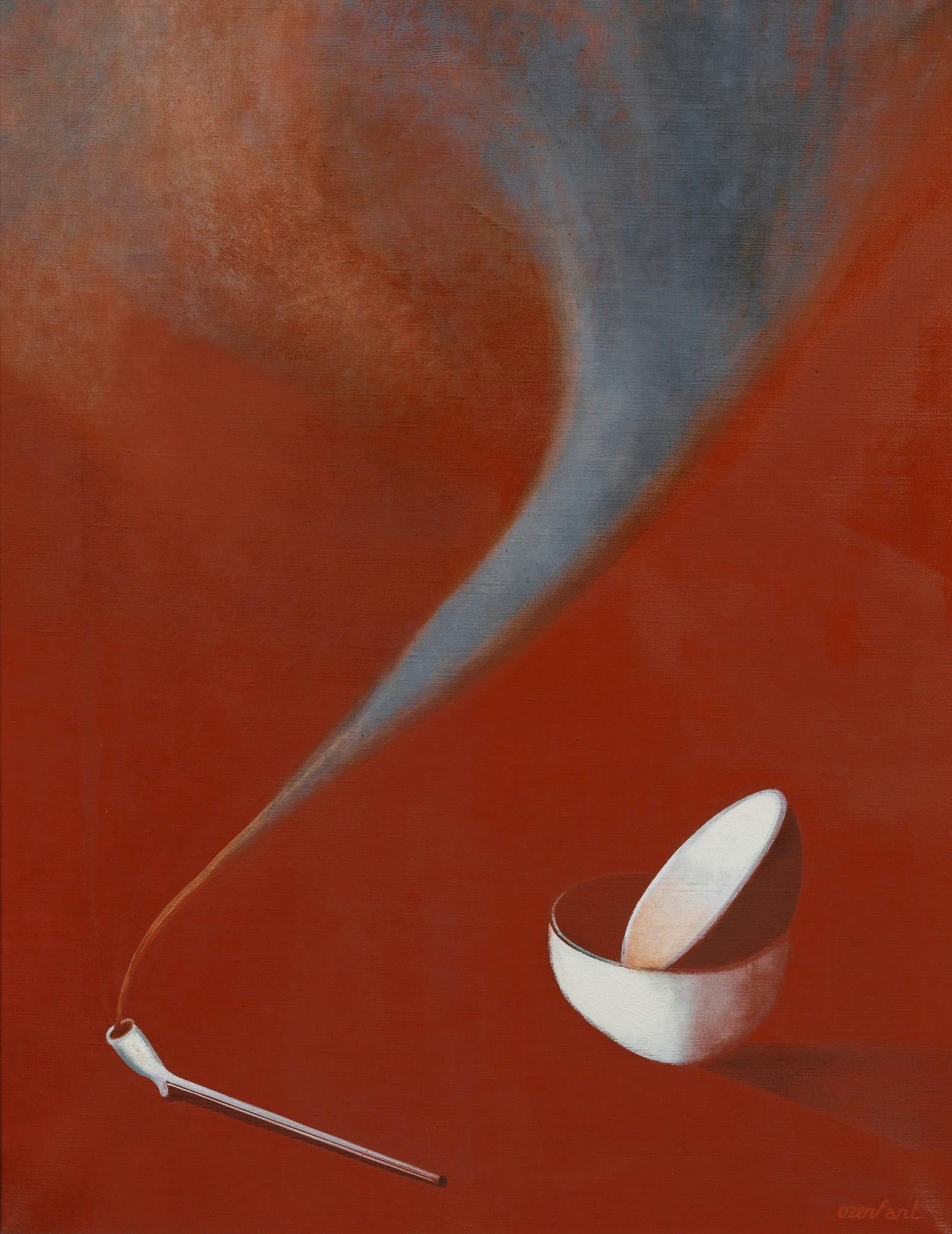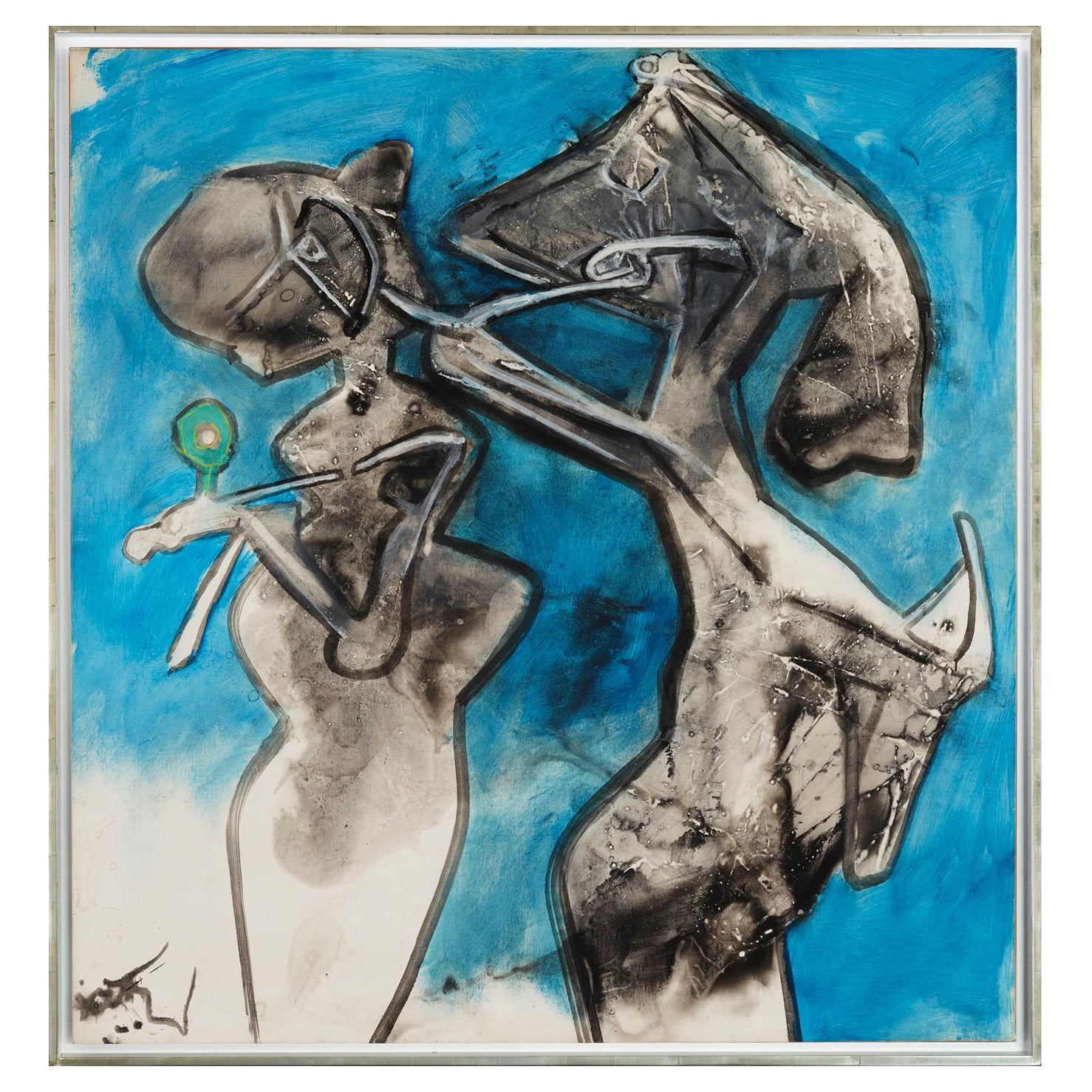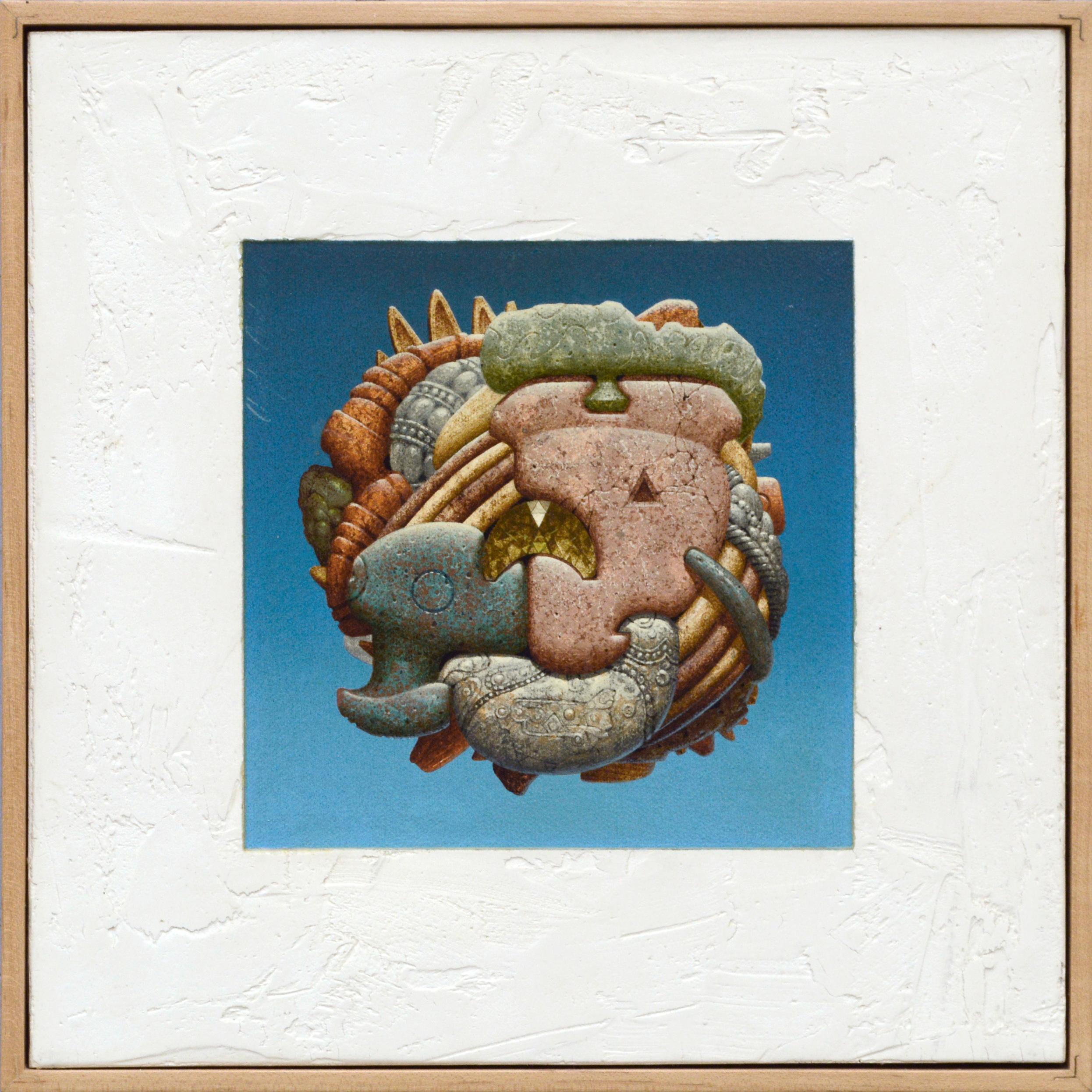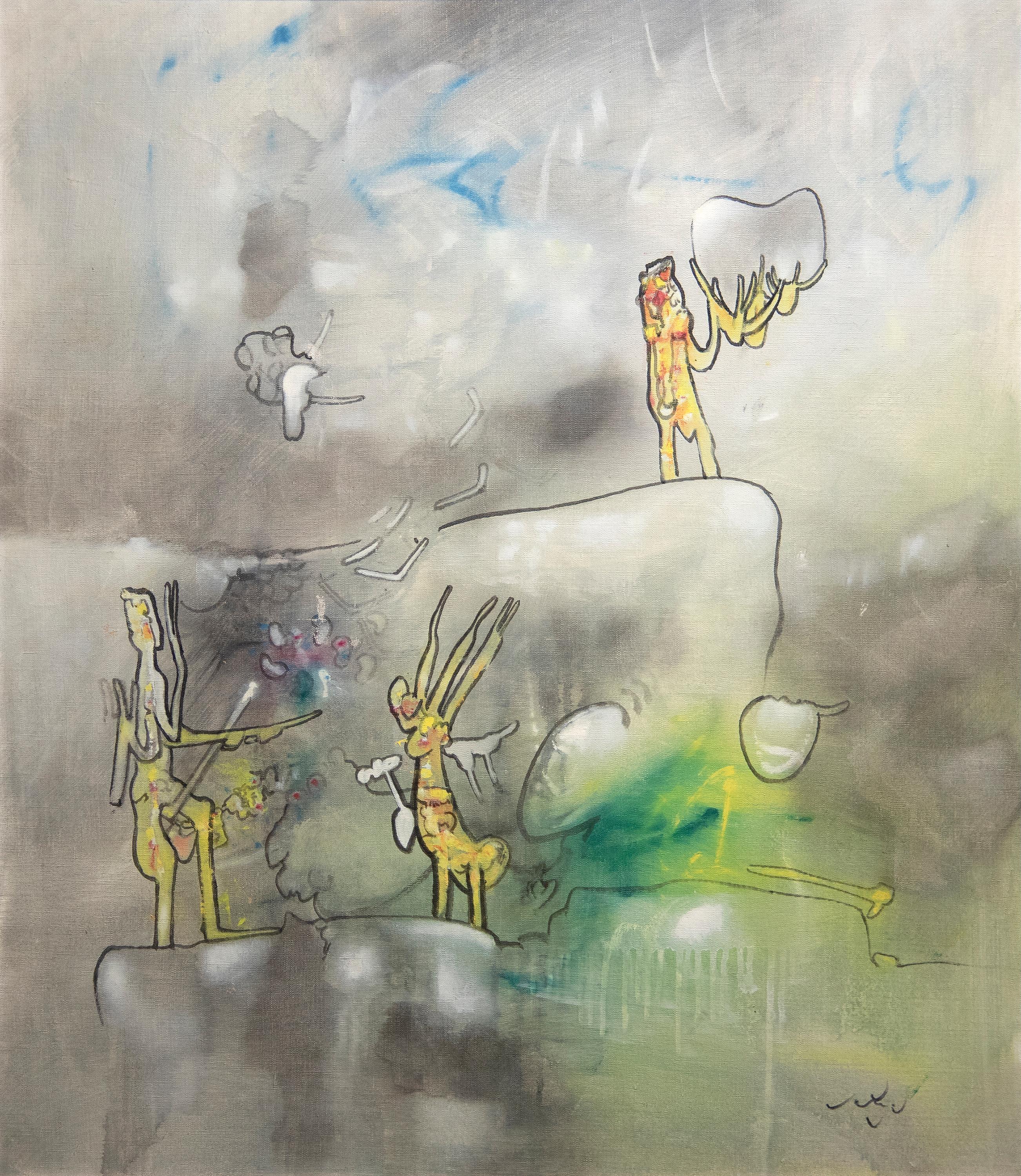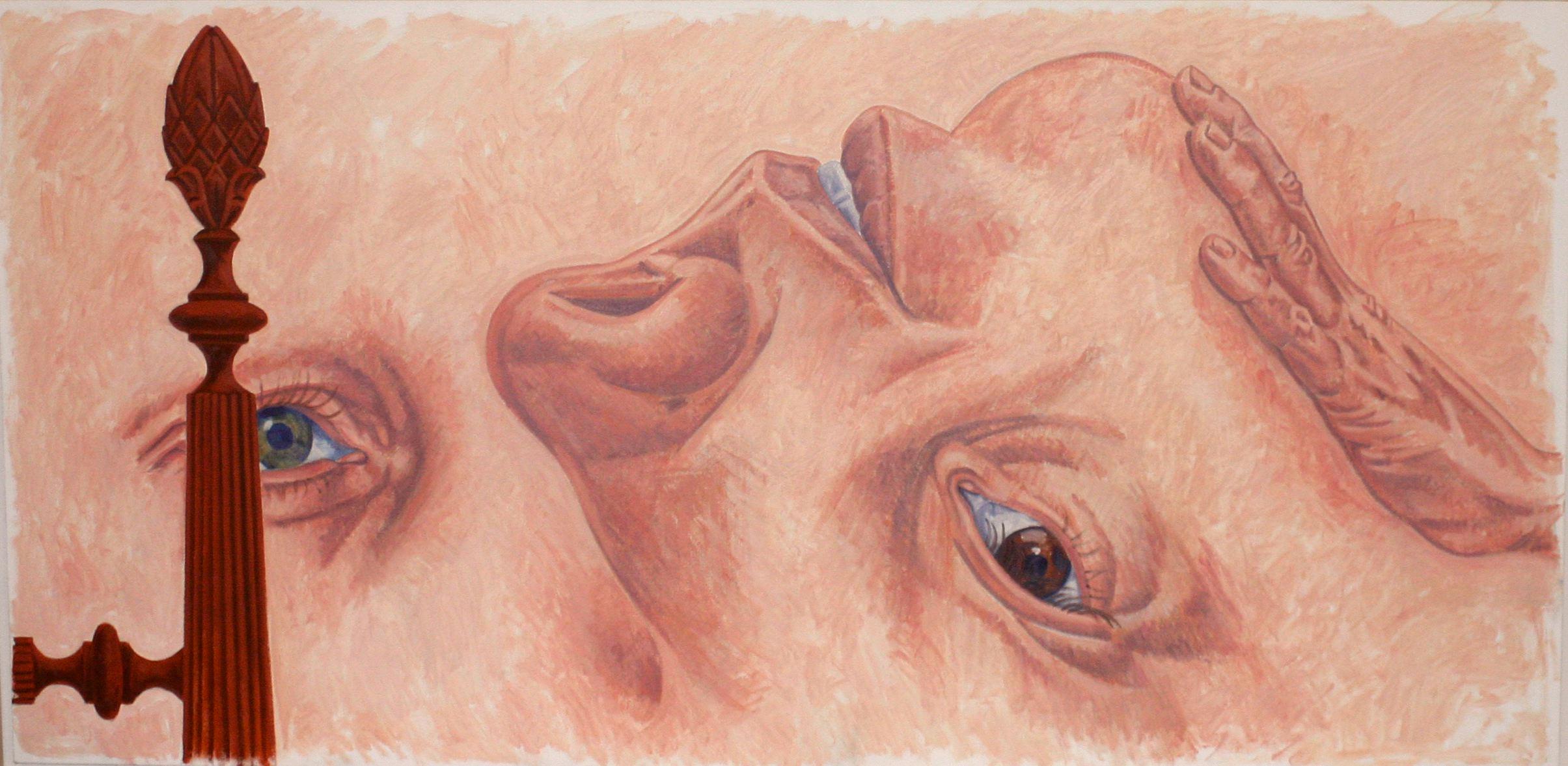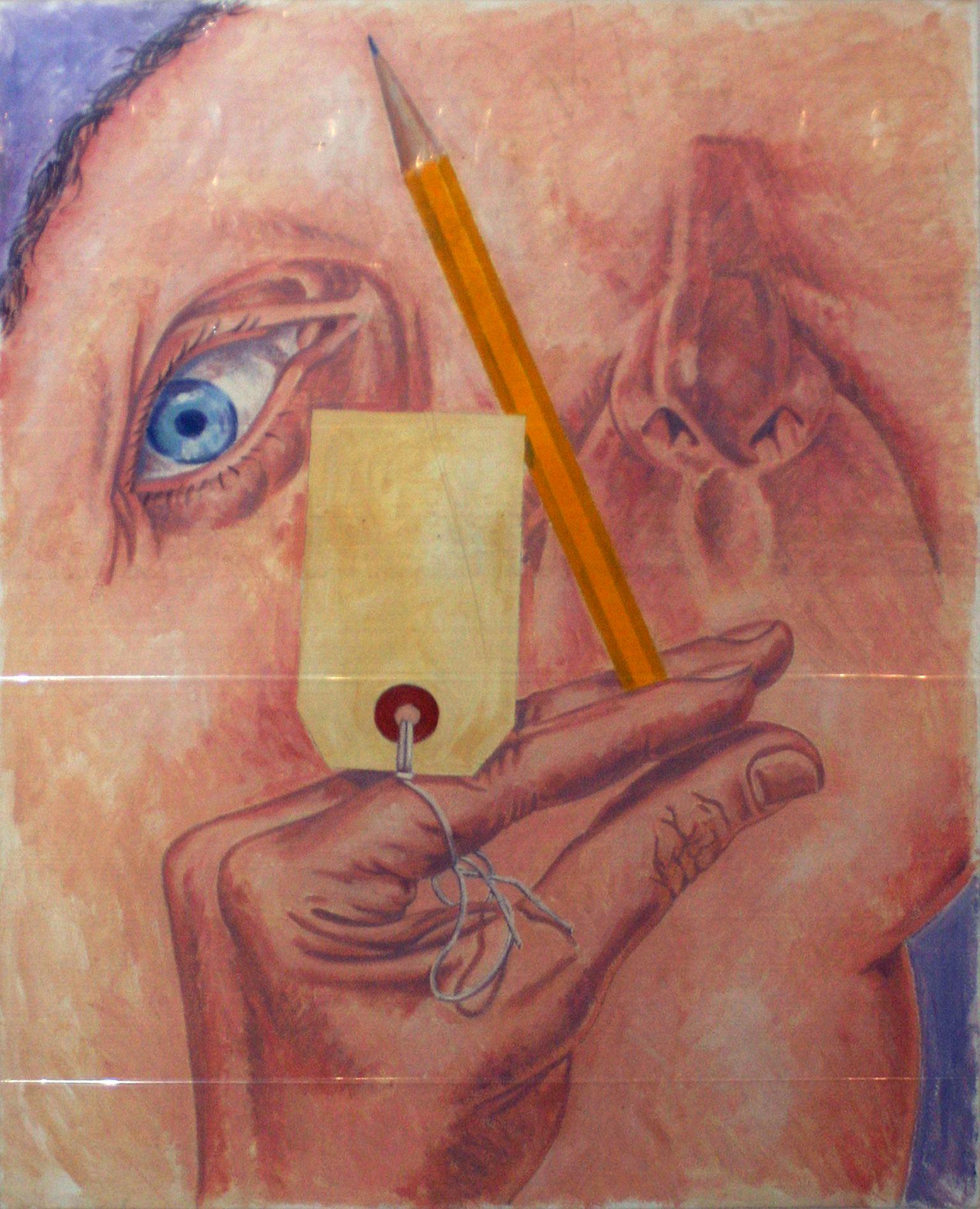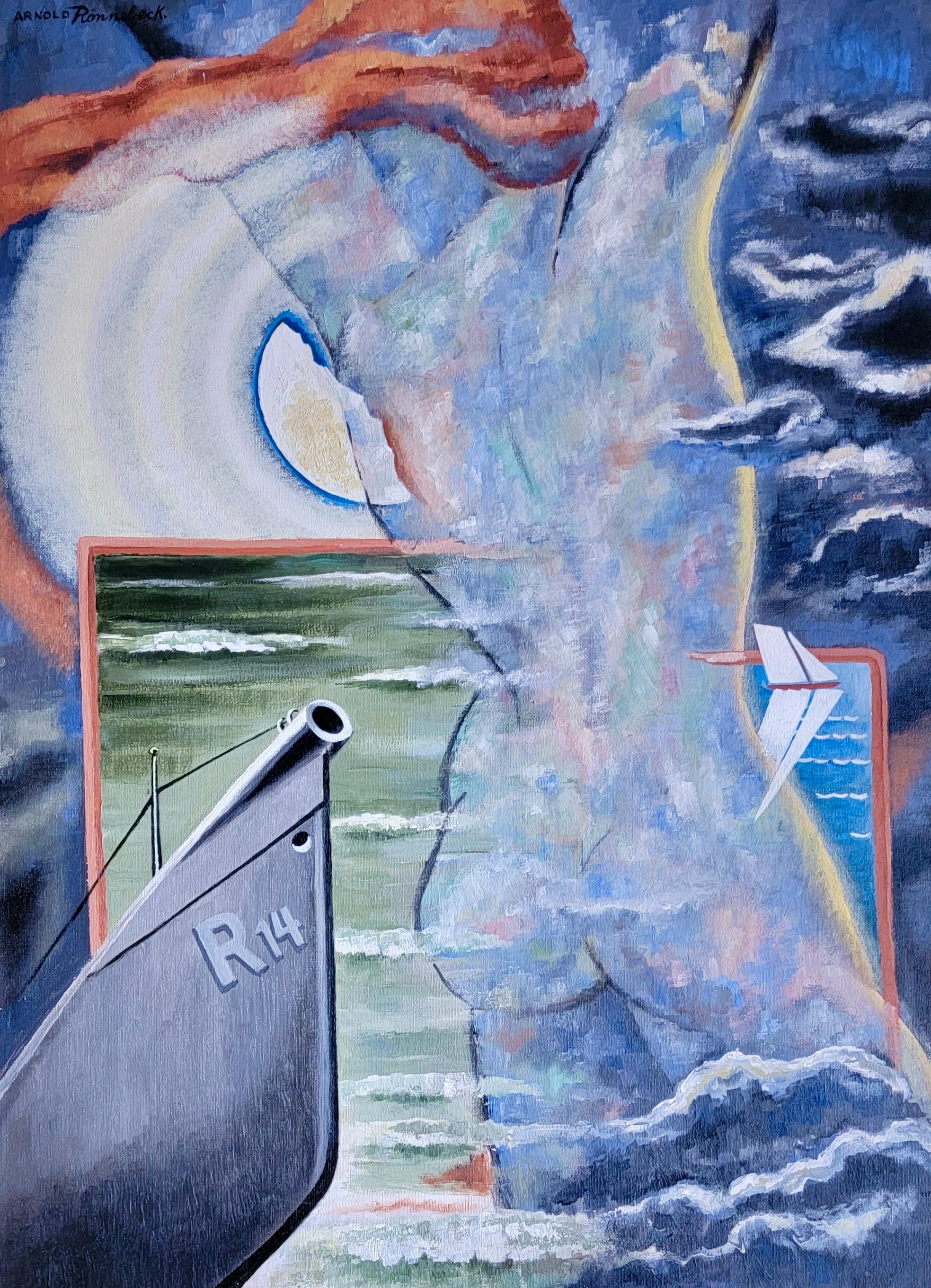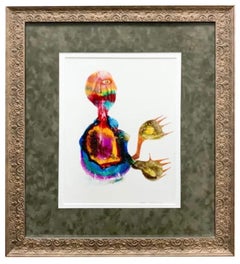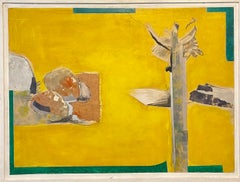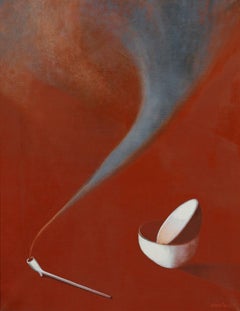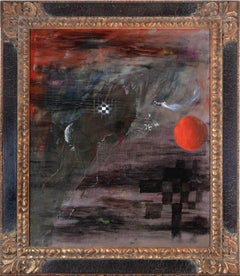French Surrealist Abstract Painting
View Similar Items
Want more images or videos?
Request additional images or videos from the seller
1 of 9
Georges DussauFrench Surrealist Abstract Painting
About the Item
- Creator:Georges Dussau (French)
- Dimensions:Height: 35.75 in (90.81 cm)Width: 46.5 in (118.11 cm)
- Movement & Style:
- Period:
- Condition:
- Gallery Location:Surfside, FL
- Reference Number:1stDibs: LU382630562
About the Seller
4.9
Platinum Seller
These expertly vetted sellers are 1stDibs' most experienced sellers and are rated highest by our customers.
Established in 1995
1stDibs seller since 2014
1,549 sales on 1stDibs
Typical response time: 1 hour
More From This SellerView All
- Jules Perahim Surrealism Oil Painting on Paper Romanian French Surrealist FigureLocated in Surfside, FLJules Perahim (Born: 1914; Bucharest, Romania - Died: 2008; Paris, France) Oil painting on paper depicting a figure with abstract multicolor design. (thi...Category
1960s Surrealist Figurative Paintings
MaterialsPaper, Oil
- 1970 Mod Surrealist Painting Collage David Hare Abstract Landscape Summer LandBy David HareLocated in Surfside, FLDavid Hare Summer Land, 1970 Acrylic or oil paint and collage on board Dimensions: 26 X 36 inches. Framed measuring 29 x 38 inches. Hand signed, dated and titled on tape to verso 'Summer Land 1970 Hare'. Provenance: Hamilton Gallery of Contemporary Art, New York David Hare (1917 – 1992) was an American artist, associated with the Surrealist movement. He is primarily known for his sculpture, though he also worked extensively in photography and oil painting. The VVV Surrealism Magazine was first published and edited by Hare in 1942. Born March 10, 1917 in New York City, New York to father Meredith Hare, a lawyer and mother Elizabeth Sage Goodwin, an art collector. In the 1920s the family moved first to Santa Fe, New Mexico and later to Colorado Springs, Colorado, in hope that the fresh air would help heal Meredith Hare's tuberculosis. His mother founded the Fountain Valley School, where David attended high school. After high school Hare married and moved to Roxbury, Connecticut where he worked as a color photographer. He attended Bard College in Annandale-on-Hudson from 1936 to 1937, studying biology and chemistry. In the late 1930s, with no previous artistic training, he began to experiment with color photography. Using his previous education in chemistry Hare developed an automatist technique called "heatage" in which he heated the unfixed negative from an 8 by 10-inch plate, causing the image to ripple and distort. Hare's Surrealist experiments in photography were only one of his many projects. In 1938 he met Susanna Winslow Wilson and the couple soon married. Both David and Susanna pursued their interests in Surrealism and regularly attended Surrealist gatherings in New York Larre French restaurant on 56th street and at Breton's Greenwich Village apartment. In 1940 he received a commission from the American Museum of Natural History to document the Pueblo Indians of the American Southwest, for which he eventually produced 20 prints developed using Eastman Kodak's then-new dye transfer process (a time-consuming and complicated technique). In the same year, he also opened his own commercial photography studio in New York City and exhibited his photographs in a solo show at the Julien Levy Gallery. In the next few years, through his cousin the painter Kay Sage, he came into contact with a number of Surrealist artists who had fled their native Europe because of World War II. Hare became closely involved with the émigré Surrealist movement and collaborated closely with them on projects such as the Surrealist journal VVV, which he co founded and edited from 1941 to 1944 with André Breton, Max Ernst, and Marcel Duchamp. With numerous illustrations by Breton, Leonora Carrington, Marc Chagall, Roberto Matta, Giorgio de Chirico, MarcelDuchamp, Max Ernst, Andre Masson, Joan Miro, Enrico Donati, Dorothea Tanning, and others. Published in only four issues between 1942-44, VVV was an experimental New York-based magazine devoted to the dissemination of Surrealism. Edited by David Hare, the short-lived magazine featured contributions from some of the leading avant-garde artists of the period. David and Susanna divorce in 1945 and Breton’s wife Jacqueline Lamba...Category
1970s Surrealist Abstract Paintings
MaterialsAcrylic, Board
- French Surrealist Abstract PaintingBy Georges DussauLocated in Surfside, FLGeorges DUSSAU est né le 14 Mars 1947, à Chalon-sur-Saône (France) Il vit et travaille à Mellecey (France) et à Mougins (France) 1962 - 1963 - 1964 - Ecole de dessin - Chalon-su...Category
20th Century Surrealist Abstract Paintings
MaterialsCanvas
- Bottom of Summer Oceans, Abstract Surrealist PaintingLocated in Surfside, FLSebastian Matta-Clark was born in 1943, twin of Gordon Matta-Clark. Son Of Chilean Surrealist Roberto Matta Sebastian, known as Batan died in 1976. He showed 3 exhibitions in his sho...Category
1970s Surrealist Abstract Paintings
MaterialsCanvas, Oil
- European Polish Stage Designer Vibrant Surrealist Oil PaintingBy Armand SzainerLocated in Surfside, FLGenre: Contemporary Subject: Abstract Medium: Mixed Media Surface: Canvas Country: United States commissions for movie advertisements, stage sets, and murals in New Hampshire. Arm...Category
20th Century Surrealist Abstract Paintings
MaterialsMixed Media
- 1957 Feminist Surrealist Israeli Colorful Watercolor Painting Myriam Bat YosefLocated in Surfside, FLMyriam Bat-Yosef Surrealist abstract painting in colorful abstract shapes and shades in the style of Joan Miro Hand signed and dated Tel Aviv, 1957. frame measures 10 X 5.5 sheet measures 2.5 X 7 inches The envelope of the Peter Buch poster is just for provenance and is not included in this sale. Myriam Bat-Yosef, whose real name is Marion Hellerman, born on January 31 , 1931 in Berlin, Germany to a Jewish family from Lithuania, she is an Israeli-Icelandic artist who paints on papers, paintings, fabrics, objects and human beings for performances. Myriam Bat-Yosef currently lives and works in Paris. In 1933, her family fleeing the Nazi Holocaust, Myriam Bat-Yosef emigrates to Palestine and settles in Jaffa. In 1936, she suffers a family tragedy, her father, militant Zionist, is called to fight, still recovering from an operation of appendicitis. The incision will become infected, antibiotics did not exist yet, and her father will die in the hospital after 9 months of suffering. Myriam and her mother leave Palestine to live in Paris for three years. French is Myriam's first school language. In 1939, still fleeing Nazism, she returned to Palestine, leaving France by the last boat from Marseille. She moved to Tel Aviv with her mother, aunt and maternal grandmother. In 1940, she began attending the Academy of Fine Arts in Tel Aviv and took her name as an artist, Bat-Yosef, which means Joseph's daughter in Hebrew, as a tribute to her father. In 1946, Myriam graduated as a kindergarten teacher but wanted to be an artist. Her mother enrolled her in an evening school to prepare a diploma of art teacher. At 19, she performs two years of military service in Israel. In 1952, with a pension of $50 a month that her mother allocated, she went to study at the Beaux-Arts in Paris. To survive, she has several activities while studying. In 1955, she had her first solo exhibition, at the Israeli Club on Wagram Avenue in Paris. Many artists, such as Yaacov Agam, Yehuda Neiman Avigdor Arikha, Raffi Kaiser, Dani Karavan and sculptors Achiam and Shlomo Selinger attended the opening . In 1956, she enrolled at the School of Fine Arts in Florence. This is where she meets the painter Errô. They share an icy studio in winter. Myriam moves to Milan with friends. She organizes a joint exhibition with Erro, one room each, at the Montenapoleone gallery. Her works are admired by the sculptor Marino Marini and the painters Renato Birolli and Enrico Prampolini. Myriam and Erro exhibit in Rome, Milan, Florence and meet many personalities: Alain Jouffroy and his wife, the painter Manina, Roberto Matta and his wife Malitte, textile artist who was one of the founders of the Pompidou Center. Back in Paris, Myriam and Erro get married, which allows Myriam to avoid being called into the Israeli army during the Suez Canal War. In 1957, Myriam and her husband went to Iceland. Myriam works in a chocolate factory. Having enough money, she starts producing art again. She exhibited in Reykjavik's first art gallery. She meets the artist Sigridur Bjornsdottir, married to the Swiss painter Dieter Roth . In 1958, Myriam and her husband leave for Israel. They exhibit in Germany, then in Israel. Back in Paris, the couple became friends with artists of the surrealist movement, such as Victor Brauner, Hans Bellmer, the sculptor Philippe Hiquily, Liliane Lijn, future wife of Takis and photographer Nathalie Waag. Erro and Myriam have a daughter on March 15, 1960, named Tura, after the painter Cosmè Tura, but also close to the Icelandic Thora or the Hebrew Torah. Bat-Yosef’s complex trajectory throughout the 20th century is linked as much to the transnational history of what was for a time called the School of Paris as it is to a certain legacy of Surrealism. Her work features the same idea of resolving antinomies that also defined the spirit of surrealism, and is enhanced with her readings of the Kabbalah and her spiritual grounding in Taoism. However, while there are reasons for her approach to be associated with the process of the ready-made, it is important to consider the immediate intrication of these works with her practice of performance, during which the body itself is also painted – a feminist response to Yves Klein’s Anthropometries (1960) and an echo of the happenings which Jean-Jacques Lebel organised at the time in Paris. In 1963, Erró told Myriam that if she wants to be a painter, she can not be his wife. Myriam chose to be a painter and the couple divorced in 1964. Since that time, Myriam Bat-Yosef has exhibited in many countries: Europe, United States, Japan, etc. Although long in the shadows, the work of Myriam Bat-Yosef has been greeted by many artists and personalities: Anaïs Nin, Nancy Huston, André Pieyre of Mandiargues, José Pierre, René de Solier , Jacques Lacarrière, Alain Bosquet, Pierre Restany, Sarane Alexandrian and Surrealist André Breton who, after a visit to her studio, confided to having been intrigued by its phantasmagorical dimension. She was included in the book Pop Art and Beyond: Gender, Race, and Class in the Global Sixties by Mona Hadler and Kalliopi Minioudaki. Extract "World Citizen, Artist of the Pop Era Sarah Wilson; Why do we know so little of Myriam Bat-Yosef, the most important female Israeli artist of the Pop era? Issues of identity and sexuality feature constantly in her work. She exhibited internationally from Reykjavik to Tokyo; she had two shows at Arturo Schwarz’s famous Dada/surrealist gallery in Milan; she participated in feminist art events in Los Angeles. Above all, in 1971, she conceived Total Art, a Pop Gesamtkunstwerk inside and outside the Israel Museum, Jerusalem. Painter, performer, and installation artist, she was also a lover, wife, and mother. Of Lithuanian-Jewish descent, she was close to the family of philosopher Emmanuel Levinas. An émigré in Paris she would repudiate a national passport, participating in Garry Davis’s short-lived “World Citizens” movement. She continues the lineage of women surrealist artists: Valentine Hugo, Leonor Fini, Dorothea Tanning, Leonora Carrington, Unica Zürn, Jane Graverol, Toyen, Alice Rahon...Category
1950s Surrealist Abstract Paintings
MaterialsWatercolor
You May Also Like
- Amédée Ozenfant - Nature morte, Tabagie, french, modern, still life, surrealBy Amédée OzenfantLocated in London, GBsigned ‘ozenfant’ (lower right) Provenance: Sale: Christie's London, 4 April 1989, lot 198 Dr. Arthur Brandt, New York (acquired at the above sale) Literature: P. & M. Guénégan, 'A...Category
1960s Surrealist Still-life Paintings
MaterialsCanvas, Oil
- Tapies Mid-Century Dau al Set Dada Spain Abstract Surrealism Dark Monster SignedBy Antoni TàpiesLocated in Milwaukee, WI"Sarpta" is an original oil on canvas painting created by Antoni Tapies. This is a fantastically dark mid-century abstract painting. There is a monstrous figure barely visible on the...Category
Mid-20th Century Surrealist Abstract Paintings
MaterialsCanvas, Oil
- Les travailleurs de la mèreBy Roberto MattaLocated in Malmo, SEArtwork size: 102,5x98 cm Frame size: 110x105 cm This artwork is accompanied by a certificate of authenticity signed by Alisée Matta. Provenance: Artist Jean-Pierre Jouffroy, Paris. The estate of the artist Jean-Pierre Jouffroy, Paris. “The heart is an eye,” writes Nobel laureate Octavio Paz in an essay on Matta’s paintings. Matta creates a world coloured both by a sunny faith in the future and by visions of impending doom. Roberto Sebastian Echaurren Antonio Matta, who died aged 91 on 23 November 2002, was born in Santiago, Chile, on 11 November 1911 into a family with Spanish, French and Basque roots, and raised in an atmosphere of religiosity. By the age of 21 he had graduated and begun work as an architect, but his leisure time he devoted to sketching and painting. In 1933 he travelled to Europe for the first time, visiting Greece, Yugoslavia, Italy and other countries, and subsequently taking the initiative to collaborate with the architect, Le Corbusier. As time passed, however, Matta’s enthusiasm for a career in architecture waned, and he began to devote himself full-time to art, making early acquaintances with surrealists such as Max Ernst, Salvador Dalí, André Breton and others. Between 1939 and 1948 Matta, like many of his artistic contemporaries, lived in self-imposed exile in the USA, but, after almost 10 years’ absence from Europe, he returned to make first Rome and then, a few years later, Paris his home. Throughout most of the rest of his life Matta commuted between his studio in Paris and his creative refuge in the monastery outside Rome. And it is here, in Italy, that he produced his greatest paintings. Matta’s first retrospective in Sweden was organised in 1956 when his works were exhibited in what was then Galerie Colibri – run by, among others, the artist C O Hultén...Category
1980s Surrealist Paintings
MaterialsCanvas, Oil
- Vintage Surrealist Composition - Precious Stones AbstractBy Clayton AndersonLocated in Soquel, CAHighly detailed surrealist composition evoking tribal, abstracted carved stone-like shapes fitting together like a three dimensional sphere shaped puzzle, floating in a sky blue space by Clayton Anderson (American b. 1943). Textured plaster border around the edge of the piece. Signed "Clayton Anderson" along the upper left edge and on verso. Presented in a deep maple box frame. Clayton Anderson (American, b. 1943) studied at the Pennsylvania Academy of the Fine Arts and worked with Ben Kimihira, Walter...Category
1970s Surrealist Abstract Paintings
MaterialsPlaster, Oil, Wood Panel
$1,880 Sale Price20% Off - Surrealist Landscape Una Via Romana Antica con Temporale Distante. Italian SceneBy Eugene BermanLocated in Miami, FLSigned "E.B." in a cartouche panel in the upper center, which is repeated on the verso. Includes 19 on the left side and 62 on the right side. h: 33.2 x w: 19.5 in / h: 84.3 x w: 49...Category
1960s Surrealist Landscape Paintings
MaterialsOil, Canvas
- L'epreuveBy Roberto MattaLocated in Palm Desert, CAA painting by Roberto Matta. "L'epreuve" is a surrealist painting, oil on canvas in palette of grays, greens, and yellows by Latin American artist Roberto Matta. It is signed in the ...Category
Mid-20th Century Surrealist Abstract Paintings
MaterialsCanvas, Oil
